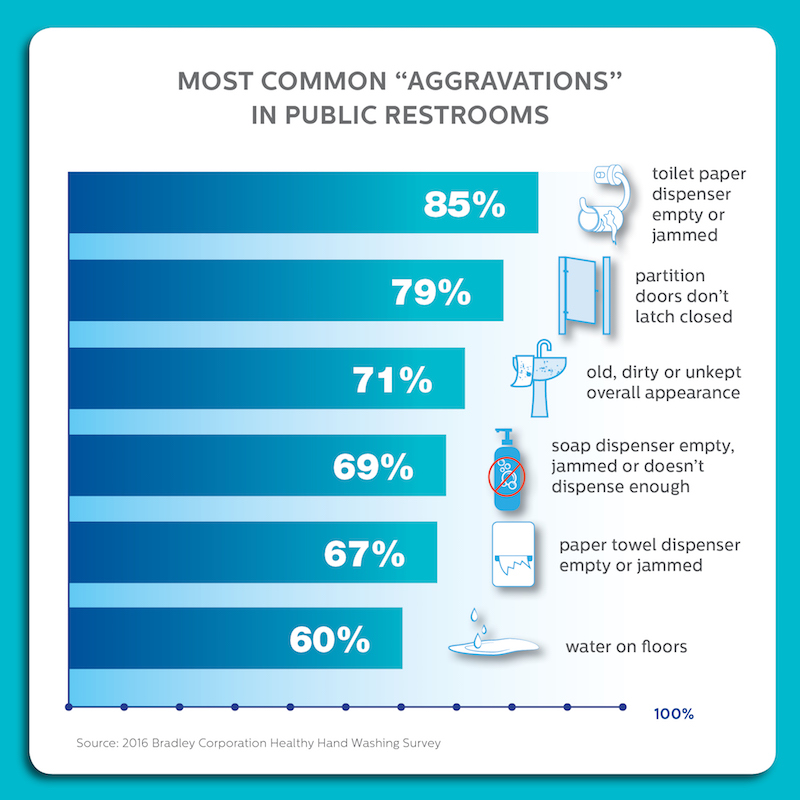According to a survey that tracks Americans’ attitudes toward restroom facilities, almost 70% report that they’ve had a particularly unpleasant experience in a public restroom due to the condition of the facilities—a nearly 20% increase since 2012.
That’s bad news for businesses, since Americans say they judge establishments based on the state of their restrooms. According to the 2016 Healthy Hand Washing Survey, conducted by Bradley Corporation, most consumers believe a bad restroom indicates poor management, lowers their opinion of the company, shows the business doesn’t care about customers, and makes them think the company is lazy or sloppy.
Bradley also delved into what factors makes restrooms so unappealing. Chief restroom grievances include toilets that are clogged or not flushed; a really bad smell; an overall appearance that’s dirty, unkempt, or old; and partition doors that don’t latch closed.
Key restroom improvements Americans would most like to see include improved cleanliness, a completely touchless experience, better stocking of restroom supplies, and a never-ending supply of paper towels—even if there are dryers.
 Inforgraphic: Bradley Corporation
Inforgraphic: Bradley Corporation
As for restroom improvements they’ve seen over the past two to three years in specific types of facilities, respondents gave the highest marks to medical buildings, airports, restaurants, and higher education facilities. At the other end of the spectrum, restrooms in convenience stores, gas stations, and truck stops deteriorated the most.
Americans make no secret about their disdain for coming into contact with germs in public restrooms. Restroom entrance door handles, stall handles, and faucet handles are the surfaces that make them the most squeamish. Almost 60% of respondents say they operate the toilet flusher with their foot to avoid germs. More than half use a paper towel to cover the door handle, while others use their back side to open and close doors.
The Healthy Hand Washing Survey queried 1,062 American adults online December 10-13, 2015, about their handwashing habits in public restrooms and concerns about germs, colds, and the flu. Participants were from around the country, were 18 years and older, and were fairly evenly split between men and women (47% and 53%).
 Inforgraphic: Bradley Corporation
Inforgraphic: Bradley Corporation
Related Stories
Apartments | Aug 14, 2023
Yardi Matrix updates near-term multifamily supply forecast
The multifamily housing supply could increase by up to nearly 7% by the end of 2023, states the latest Multifamily Supply Forecast from Yardi Matrix.
Sports and Recreational Facilities | Jul 26, 2023
10 ways public aquatic centers and recreation centers benefit community health
A new report from HMC Architects explores the critical role aquatic centers and recreation centers play in society and how they can make a lasting, positive impact on the people they serve.
Market Data | Jul 24, 2023
Leading economists call for 2% increase in building construction spending in 2024
Following a 19.7% surge in spending for commercial, institutional, and industrial buildings in 2023, leading construction industry economists expect spending growth to come back to earth in 2024, according to the July 2023 AIA Consensus Construction Forecast Panel.
Codes and Standards | Jul 17, 2023
Outdated federal rainfall analysis impacting infrastructure projects, flood insurance
Severe rainstorms, sometimes described as “atmospheric rivers” or “torrential thunderstorms,” are making the concept of a “1-in-100-year flood event” obsolete, according to a report from First Street Foundation, an organization focused on weather risk research.
Multifamily Housing | Jul 13, 2023
Walkable neighborhoods encourage stronger sense of community
Adults who live in walkable neighborhoods are more likely to interact with their neighbors and have a stronger sense of community than people who live in car-dependent communities, according to a report by the Herbert Wertheim School of Public Health and Human Longevity Science at University of California San Diego.
Multifamily Housing | Jun 29, 2023
5 ways to rethink the future of multifamily development and design
The Gensler Research Institute’s investigation into the residential experience indicates a need for fresh perspectives on residential design and development, challenging norms, and raising the bar.
Apartments | Jun 27, 2023
Average U.S. apartment rent reached all-time high in May, at $1,716
Multifamily rents continued to increase through the first half of 2023, despite challenges for the sector and continuing economic uncertainty. But job growth has remained robust and new households keep forming, creating apartment demand and ongoing rent growth. The average U.S. apartment rent reached an all-time high of $1,716 in May.
Contractors | Jun 26, 2023
Most top U.S. contractors rarely deliver projects on time: new study
About 63% of leading U.S. contractors are delivering projects out of schedule, according to a survey of over 300 C-suite executives and owners in the construction industry by XYZ Reality. The study implies that the industry is struggling with significant backlogs due, in part, to avoidable defects, scan, and rework.
Industry Research | Jun 15, 2023
Exurbs and emerging suburbs having fastest population growth, says Cushman & Wakefield
Recently released county and metro-level population growth data by the U.S. Census Bureau shows that the fastest growing areas are found in exurbs and emerging suburbs.
Contractors | Jun 13, 2023
The average U.S. contractor has 8.9 months worth of construction work in the pipeline, as of May 2023
Associated Builders and Contractors reported that its Construction Backlog Indicator remained unchanged at 8.9 months in May, according to an ABC member survey conducted May 20 to June 7. The reading is 0.1 months lower than in May 2022. Backlog in the infrastructure category ticked up again and has now returned to May 2022 levels. On a regional basis, backlog increased in every region but the Northeast.

















